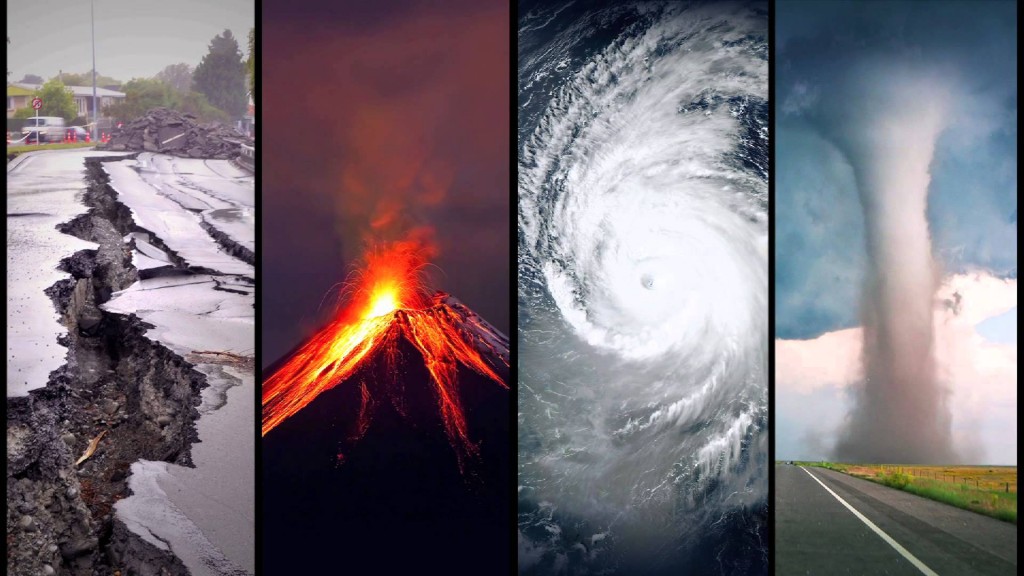10 Major Natural Disasters Predicted Soon!
10. Wild fires, U.S., 2015-2050

Environmental scientists from the Harvard School of Engineering and Applied Sciences (SEAS) predict that by 2050, wildfire seasons in the US will be three weeks longer.
The acreage burned by wildfires in the US has tripled from 2.2 million to 6.4 million annually from 1999, meaning that much more of the US will be up in flames in the near future.
According to SEAS, this is because of gradual climate change, creating conditions that spawn bigger and fiercer wildfires. They also predict 30,000–50,000 wildfires to occur annually.
9. Volcanic Explosion, Iceland, 2014 Baroarbunga Volcano

This prediction came true within a few weeks of it being made.
In August 2014, the Icelandic Meteorological Office increased the risk level for a possible eruption of Baroarbunga, a volcano located in Iceland. This was due to hundreds of eruptions.
On August 23, 2014, the volcano began erupting underneath the Dyngjujokull glacier. Over the course of the next week, thousands of earthquakes occurred near Baroarbunga.
The fissure erupted for six months, officially ending on February 28, 2015. The fissure emitted, on average, enough lava to fill an American football stadium every five minutes.
The Baroarbunga eruption of 2014 was the largest Icelandic eruption since the eruption of Baroarbunga’s Laki fissure in 1783.
8. Megathrust Earthquake, Chile, 2015–2065

On April 1, 2014, a magnitude 8.2 earthquake occurred 97 kilometers (60 mi) off the northwest coast of Chile near the city of Iquique.
This earthquake created the possibility for an even larger earthquake for Chile in the near future due to the location of the earthquake.
The Iquique earthquake originated from a subduction zone where one tectonic plate, the Nazca Plate, is plunging underneath another, the South American Plate.
When a tectonic plate moves under another, the faults can come under severe amounts of stress, and any release of tension causes seismic activity, namely earthquakes.
The April 2014 earthquake was a “megathrust” earthquake. It only relieved 33 percent of the tension on the fault, leaving the rest to be relieved in the near future.
7. Twin Earthquake, Japan, 2017

Occurring on March 11, 2011, the magnitude 9.0 Tohoku earthquake struck off the coast northeast of Tokyo and created a tsunami that hit Japan.
Dr. Kimura has stated that he predicted the Tohoku earthquake four years before it happened, but his prediction and evidence were ignored by the Pacific Science Congress.
His hypotheses have been based upon his concept of “earthquake eyes,” regions that have many small earthquakes that are commonly ignored.
Dr. Kimura believes that these earthquake eyes are the best predictors of where and when a major earthquake will occur.
Kimura believes that the new earthquake will begin in the Izu Islands and will be a magnitude 9.0. It will cause a tsunami to hit Japan in a very similar fashion to the Tohoku earthquake.
6. Mt. Fuji Eruption, Japan, 2015–2053

When the Tohoku earthquake shifted the landmass of Japan, 20 of the 110 active volcanoes in Japan showed increased seismic activity.
Experts now believe one may erupt any day.
The Japan Meteorological Agency (JMA) monitors seismic activity and active volcanoes in Japan and believe that an eruption will occur soon.
Mt. Fuji is among the volcanoes most likely to erupt, causing concern for many Japanese citizens. Mt. Fuji is located only 100 kilometers (62 mi) from Tokyo.
If Mt. Fuji erupted, the team predicts that it would necessitate the emergency evacuation of 750,000 people from Tokyo. The city would most likely be covered in ash.
5. Earthquake-Tsunami Split, Oregon, 2015-2065

The OSSPAC predicts that an 8.0–9.0 magnitude earthquake and tsunami will occur off the coast of Oregon within the next 50 years.
The possible source of this catastrophic earthquake-tsunami split is the Cascadia subduction zone, 97 kilometers (60 mi) offshore from Oregon.
The Juan de Fuca and North American continental tectonic plates create this subduction zone, which is considered the “quietest subduction zone in the world”
This occurrence has been predicted since 2010; the Commission now states that it will inevitably occur.
This predicted earthquake and tsunami will potentially kill over 10,000 people, possibly splitting apart portions of the West Coast.
4. East Coast Submersion, US, 2050–2100

Current sea level trends along the East Coast may leave major cities underwater by 2050.
Professor John Boon of the Virginia Institute of Marine Science claimed that significant changes in sea level along the East coast started around 1987.
His study shows that the sea level is increasing 0.3 mm per year. He also states that the sea level of the East Coast is rising three or four times faster than anywhere else in the world.
This is why ex–New York Mayor Michael Bloomberg proposed a $20 billion flood system in 2013 for NYC before he left office, but this plan was not put into action.
3. Largest Tsunami Ever, Caribbean, Unknown

Dr. Simon Day of UCL and Dr. Steven Ward from the UOC Santa Cruz predict that the Cumbre Vieja volcano on the Canary Islands will erupt and create the largest tsunami in recorded history.
They state that a rupture in the volcano’s structure occurred during its last eruption, causing the left side to have become particularly unstable.
If Cumbre Vieja were ever to erupt again, its left side would turn into a landslide that would cause the biggest tsunami in the history of man.
They say the monstrous wave will travel at 800 kilometers per hour (500 mph), be 100 meters (330 ft) tall upon first impact with land.
It will reach Florida within nine hours of being created and they also predict that tsunamis will hit faraway places such as England, Florida, and the Caribbean.
2. The “Big One”, California, 2015-2045

The US Geological Survey has increased the probability of the likelihood of a magnitude 8.0 or larger earthquake hitting California within the next few decades.
The “Big One” refers to the earthquake that many Californians have been waiting for years.
The magnitude 8.0 earthquake or larger quake has a 7 percent chance of occurring in the next 30 years. The odds of a magnitude 6.5–7.0 earthquake hitting are 30 percent.
If it were to hit, it would most likely come from the breaking of the San Andreas Fault, spanning the distance in southern California inland from Los Angeles.
Though no matter where the earthquake comes from, it is predicted to devastate all of California and other parts of the West Coast.
1. Major Solar Storm 2015-2025

The Sun has an “activity cycle,” which means that it has either decreased or increased activity, such as solar flares and sunspots, depending on its time in a particular cycle.
After analyzing solar storm records from the past 50 years, calculations concluded that there is a 12 percent chance of a major solar storm hitting Earth in the next 10 years.
If this were to happen, it would potentially interfere with radio, GPS, and satellite communications, affecting the use of millions of electronics around the world.
Power grids would also be affected due to power surges caused by the energetic particles, possibly causing major worldwide blackouts.
The economic costs are estimated to be $1–2 trillion in the first year of impact, with a full recovery taking 4–10 years according to the National Research Council.


